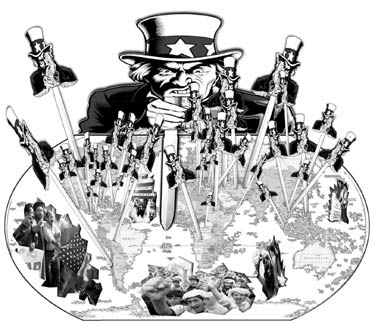![]()
Write us!
socialistviewpoint@pacbell.net
The US Global Empire
By Laurence M. Vance

There is a new empire in town, and its global presence is increasing every day.
The kingdom of Alexander the Great reached all the way to the borders of India. The Roman Empire controlled the Celtic regions of Northern Europe and all of the Hellenized states that bordered the Mediterranean. The Mongol Empire, which was the largest contiguous empire in history, stretched from Southeast Asia to Europe. The Byzantine Empire spanned the years 395 to 1453. In the sixteenth century, the Ottoman Empire stretched from the Persian Gulf in the east to Hungary in the northwest; and from Egypt in the south to the Caucasus in the north. At the height of its dominion, the British Empire included almost a quarter of the world’s population.
Nothing, however, compares to the U.S. global empire. What makes U.S. hegemony unique is that it consists, not of control over great land masses or population centers, but of a global presence unlike that of any other country in history.
The extent of the U.S. global empire is almost incalculable. The latest “Base Structure Report” of the Department of Defense states that the Department’s physical assets consist of “more than 600,000 individual buildings and structures, at more than 6,000 locations, on more than 30 million acres.” The exact number of locations is then given as 6,702—divided into large installations (115), medium installations (115), and small installations/locations (6,472). This classification can be deceiving, however, because installations are only classified as small if they have a Plant Replacement Value (PRV) of less than $800 million.
Although most of these locations are in the continental United States, 96 of them are in U.S. territories around the globe, and 702 of them are in foreign countries. But as Chalmers Johnson has documented, the figure of 702 foreign military installations is too low, for it does not include installations in Afghanistan, Iraq, Israel, Kosovo, Kuwait, Kyrgyzstan, Qatar, and Uzbekistan. Johnson estimates that an honest count would be closer to 1,000.
The number of countries that the United States has a presence in is staggering. According the U.S. Department of State’s list of “Independent States in the World,” there are 192 countries in the world, all of which, except Bhutan, Cuba, Iran, and North Korea, have diplomatic relations with the United States. All of these countries except one (Vatican City) are members of the United Nations. According to the Department of Defense publication, “Active Duty Military Personnel Strengths by Regional Area and by Country,” the United States has troops in 135 countries. Here is the list:
Afghanistan, Albania, Algeria, Antigua, Argentina, Australia, Austria, Azerbaijan, Bahamas, Bahrain, Bangladesh, Barbados, Belgium, Belize, Bolivia, Bosnia and Herzegovina, Botswana, Brazil, Bulgaria, Burma, Burundi, Cambodia, Cameroon, Canada, Chad, Chile, China, Columbia, Congo, Costa Rica, Cote D’lvoire, Cuba, Cyprus, Czech Republic, Denmark, Djibouti, Dominican Republic, East Timor, Ecuador, Egypt, El Salvador, Eritrea, Estonia, Ethiopia, Fiji, Finland, France, Georgia, Germany, Ghana, Greece, Guatemala, Guinea, Haiti, Honduras, Hungary, Iceland, India, Indonesia, Iraq Ireland, Israel, Italy, Jamaica Japan Jordan, Kazakhstan, Kenya, Kuwait, Kyrgyzstan, Laos, Latvia, Lebanon, Liberia, Lithuania, Luxembourg, Macedonia, Madagascar, Malawi, Malaysia, Mali, Malta, Mexico, Mongolia, Morocco, Mozambique, Nepal, Netherlands, New Zealand, Nicaragua, Niger, Nigeria, North Korea, Norway, Oman, Pakistan, Paraguay, Peru, Philippines, Poland, Portugal, Qatar, Romania, Russia, Saudi Arabia, Senegal, Serbia and Montenegro, Sierra Leone, Singapore, Slovenia, Spain, South Africa, South Korea, Sri Lanka, Suriname, Sweden, Switzerland, Syria, Tanzania, Thailand, Togo, Trinidad Tobago, Tunisia, Turkey, Turkmenistan, Uganda, Ukraine, United Arab Emirates, United Kingdom, Uruguay, Venezuela, Vietnam, Yemen, Zambia, Zimbabwe.
This means that the United States has troops in 70 percent of the world’s countries. The average American could probably not locate half of these 135 countries on a map.
To this list could be added regions like the Indian Ocean territory of Diego Garcia, Gibraltar, and the Atlantic Ocean island of St. Helena, all still controlled by Great Britain, but not considered sovereign countries. Greenland is also home to U.S. troops, but is technically part of Denmark. Troops in two other regions, Kosovo and Hong Kong, might also be included here, but the DOD’s “Personnel Strengths” document includes U.S. troops in Kosovo under Serbia and U.S. troops in Hong Kong under China.
Possessions of the United States like Guam, Johnston Atoll, Puerto Rico, the Trust Territory of the Pacific Islands, and the Virgin Islands are likewise home to U.S. troops. Guam has over 3,200.
Regular troop strength ranges from a low of one in Malawi to a high of 74,796 in Germany. At the time the most recent “Personnel Strengths” was released by the government (September 30, 2003), there were 183,002 troops deployed to Iraq, an unspecified number of which came from U.S. forces in Germany and Italy. The total number of troops deployed abroad as of that date was 252,764, not including U.S. troops in Iraq from the United States. Total military personnel on September 30, 2003, was 1,434,377. This means that 17.6 percent of U.S. military forces were deployed on foreign soil, and certainly over 25 percent if U.S. troops in Iraq from the United States were included. But regardless of how many troops we have in each country, having troops in 135 countries is 135 countries too many.
The U. S. global empire—an empire that Alexander the Great, Caesar Augustus, Genghis Khan, Suleiman the Magnificent, Justinian, and King George V would be proud of.
Laurence M. Vance teaches Greek at Pensacola Bible Institute in Pensacola, FL.
—Laurence M. Vance Archives, March 16, 2004
Write us
socialistviewpoint@pacbell.net